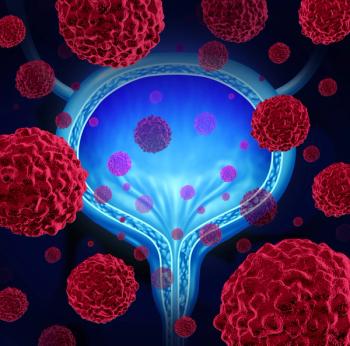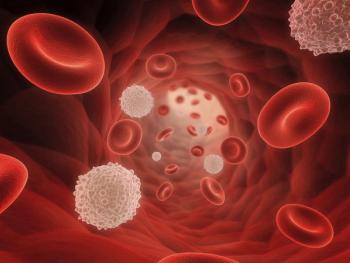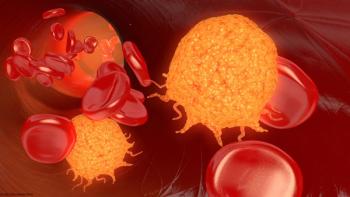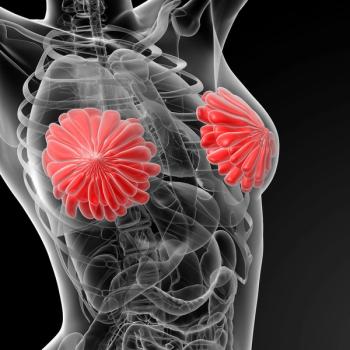
Neoadjuvant FOLFIRINOX Shows Comparable Survival vs Chemoradiation in PDAC
Serious AEs occurred in 49% of patients treated with FOLFIRNOX vs 43% of patients treated with chemoradiation for pancreatic ductal adenocarcinoma.
A chemotherapy regimen containing 5-flurouracil, oxaliplatin, irinotecan, and leucovorin (folinic acid; FOLFIRNOX) displayed comparable overall survival (OS) vs gemcitabine-based chemoradiation for the treatment of patients with resectable or borderline resectable pancreatic ductal adenocarcinoma (PDAC), according to findings from the phase 3 PREOPANC-2 trial (2017-002036-17) published in The Lancet Oncology.
Efficacy data revealed that at a median follow-up of 42.3 months (IQR, 35.7-48.7), 68% of patients treated with FOLFIRINOX had died vs 72% of patients treated with chemoradiation. The respective values for median OS were 21.9 months (95% CI, 17.7-27.0) vs 21.3 months (95% CI, 16.8-25.5; HR, 0.88; 95% CI, 0.69-1.13; P = .32), with no evidence for non-proportional hazards found (P = .96). The estimated 1- and 3-year OS rates were 76% (95% CI, 70%-82%) vs 70% (95% CI, 63%-77%) and 36% (95% CI, 30%-44%) vs 33% (95% CI, 27%-41%).
Additionally, the prespecified subgroup analyses of OS showed no treatment effect heterogeneity. In the resectable PDAC subgroup, the median OS was 21.5 months (95% CI, 17.9-28.3) with FOLFIRNOX vs 22.5 months (95% CI, 17.4-28.1) with chemoradiation (HR, 0.93; 95% CI, 0.69-1.26; P = .64). For the borderline resectable population, the median OS was 23.4 months (95% CI, 14.8-31.7) vs 17.0 months (95% CI,12.3-28.7), respectively (HR, 0.80; 95% CI, 0.53-1.21; P = .30).
The median progression-free survival (PFS) among patients treated with FOLFIRINOX was 12.1 months (95% CI, 11.3-15.0) vs 11.9 months (95% CI, 10.0-13.7) with chemoradiation (HR, 0.84; 95% CI, 0.67-1.06; P = .14). Surgery followed neoadjuvant treatment in 84% of the FOLFIRINOX group vs 90% of the chemoradiation group (P = .090). Additionally, resection was performed in 77% vs 75% of the respective groups (P = .69).
“[T]he PREOPANC-2 trial did not show a benefit in OS for neoadjuvant FOLFIRINOX as compared with neoadjuvant gemcitabine-based chemoradiotherapy followed by adjuvant gemcitabine chemotherapy in patients with resectable and borderline resectable PDAC,” Quisette P. Janssen, MD, PhD, researcher in the Department of Surgery of the Erasmus Medical Center in Rotterdam, The Netherlands, wrote in the publication with study coinvestigators. “Based on these results, both treatment regimens may be considered in these patients.”
In the investigator-initiated phase 3 trial, patients 18 years and older with histologically or cytologically confirmed resectable or borderline resectable PDAC without evidence of distant metastases were included on the trial. Patients were randomly assigned 1:1 to receive FOLFIRINOX neoadjuvantly followed by surgery (n = 188) or neoadjuvant gemcitabine-based chemoradiation followed by surgery and adjuvant gemcitabine (n = 187). Those undergoing random assignment were stratified by resectability status and treatment center.
Patients in the FOLFIRNOX arm initially received 85 mg/m² of intravenous oxaliplatin, 400 mg/m² of intravenous leucovorin, 180 mg/m² of intravenous irinotecan, followed by a bolus of 400 mg/m² intravenous fluorouracil, and then a continuous intravenous infusion of 2400 mg/m2 of fluorouracil over 46 hours every 14 days for 8 cycles. No adjuvant treatment was scheduled, and dose modification was permitted at investigator’s discretion.
Those in the neoadjuvant chemoradiation arm received 3 cycles of neoadjuvant gemcitabine plus 36 Gy of hypofractionated radiotherapy across 15 fractions over 3 weeks added to the second cycle. Following that, patients received 4 weekly cycles of adjuvant gemcitabine. Gemcitabine was given intravenously at 1000 mg/m2 on days 1, 8, and 15 of each 28-day cycle, with the first and third cycles modified to a 3-week course.
In the neoadjuvant FOLFIRINOX and chemoradiotherapy arms, respectively, the median age was 66 years (IQR, 59-72) vs 68 years (IQR, 61-73), and 62% vs 51% of patients were male. Most patients in either arm had resectable PDAC (65% vs 66%), a WHO status of 0 (61% vs 60%), and tumors located at the head of the pancreas (83% vs 86%). In the respective arms, the median CA 19-9 levels were 164 U/mL (IQR, 52-471) vs 193 U/mL (IQR, 51-622), and the median tumor size at baseline was 29 mm (IQR, 23-35) vs 30 mm (IQR, 23-36).
The primary end point of the trial was OS. Secondary end points included PFS, locoregional failure-free interval, distant metastasis-free survival, disease-free survival, locoregional recurrence-free survival, resection rate, quality of life, and adverse effects (AEs).
AEs of grade 3 or higher were observed in 67% of the FOLFIRINOX group vs 60% of the chemoradiation group. Additionally, more than 1 grade 3 or higher AE was reported in 46% vs 34% of the respective arms. Furthermore, treatment-related deaths were seen in 2 patients in the FOLFIRNOX group due to multi-organ failure and intestinal mucositis, and 1 patient in the chemoradiation group died due to upper gastrointestinal hemorrhage.
Reference
Janssen QP, van Dam JL, van Bekkum ML, et al. Neoadjuvant FOLFIRINOX versus neoadjuvant gemcitabine-based chemoradiotherapy in resectable and borderline resectable pancreatic cancer (PREOPANC-2): a multicentre, open-label, phase 3 randomised trial. Lancet Oncol. 2025;26:1346-1356. doi:10.1016/S1470-2045(25)00363-8
Newsletter
Stay up to date on recent advances in the multidisciplinary approach to cancer.

















































































